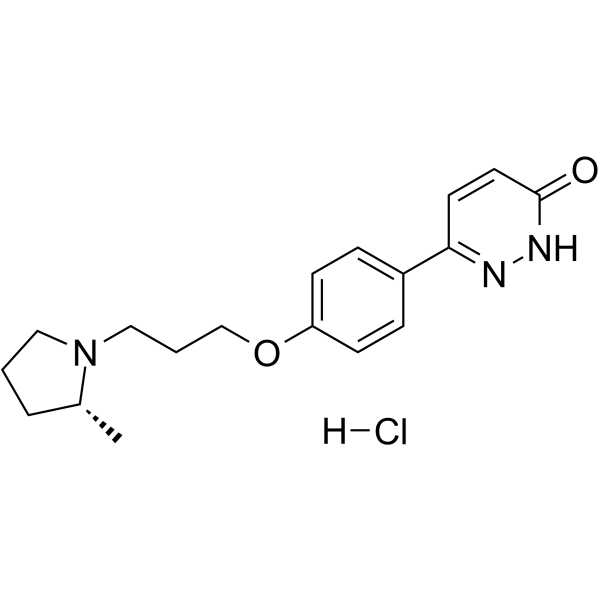1005398-61-7
| Name | 3-[4-[3-[(2R)-2-methylpyrrolidin-1-yl]propoxy]phenyl]-1H-pyridazin-6-one,hydrochloride |
|---|---|
| Synonyms |
Irdabisant HCl
UNII-M2U80Z023U IRDABISANT HYDROCHLORIDE |
| Description | Irdabisant (CEP-26401) hydrochloride is a selective, orally active and blood-brain barrier (BBB) penetrant histamine H3 receptor (H3R) inverse agonist/inverse agonist with Ki values of 7.2 nM and 2.0 nM for rat H3R and human H3R, respectively. Irdabisant hydrochloride has relatively low inhibitory activity against hERG current with an IC50 of 13.8 μM. Irdabisant hydrochloride has cognition-enhancing and wake-promoting activities in the rat social recognition model. Irdabisant hydrochloride can be used to research schizophrenia or cognitive impairment[1][2]. |
|---|---|
| Related Catalog | |
| Target |
rat H3 receptor:7.2 nM (Ki) human H3 receptor:2 nM (Ki) |
| In Vitro | Irdabisant (CEP-26401, compound 8a) shows antagonist activity with Kb, app values of 1.0 nM and 0.4 nM for rat H3R and human H3R, respectively; shows inverse agonist activity with EC50 values of 2.0 nM and 1.1 nM for rat H3R and human H3R, respectively[1]. Irdabisant has moderate activity at Muscarinic M2 (Ki = 3.7 ± 0.0 μM) and Adrenergic α1A (Ki = 9.8 ± 0.3 μM) receptors, Dopamine transporters (Ki = 11 ± 2 μM), Norepinephrine transporters (Ki = 10 ± 1 μM), and phosphodiesterase PDE3 (IC50 = 15 ± 1 μM)[1]. Irdabisant inhibits the cytochrome P450 enzymes CYP1A2, 2C9, 2C19, 2D6, and 3A4 with IC50 values of greater than 30 μM, indicating less potential for drug-drug interactions[1]. |
| In Vivo | CEP-26401 (0.01-0.3 mg/kg; p.o.; single dosage) dose-dependently inhibits H3R agonist RAMH-induced dipsogenia[1]. CEP-26401 (0.0001-0.1 mg/kg; i.v. or p.o.; single dosage) improves performance in the rat social recognition model of short-term memory[1]. CEP-26401 (3-30 mg/kg; p.o.; single dosage) exhibits wake-promoting activity in rat[2]. CEP-26401 (3-30 mg/kg; i.p.) increases prepulse inhibition (PPI) in DBA/2NCrl mice[2]. CEP-26401 (1 mg/kg for i.v. and 3 mg/kg for p.o.; single dosage) is rapidly absorbed with high oral bioavailability in rat and monkey, and shows a moderate clearance in monkey and dog compared to the rat[1]. Pharmacokinetic Parameters of Irdabisant (compound 8a) in rats, dogs and monkeys[1]. Rat Dog Monkey i.v. t1/2 (h) 2.6 2.9 5.4 i.v. Vd (L/kg) 9.4 3.5 ± 1.1 3.8 ± 0.9 i.v. CL (mL/min/kg) 42 13.2 ± 1.5 7.7 ± 1.8 p.o. t1/2 (L/kg) 2.9 2.7 5.0 p.o. AUC (ng·h/mL) 984 1190 ± 180 1919 ± 611 p.o. Cmax (ng/mL) 270 230 ± 70 760 ± 74 p.o. F (%) 83 22 ± 2 83 ± 18 Brain to plasma ratio 2.6 ± 0.2 2.4 ± 0.4 / Animal Model: Male Sprague-Dawley rats (i.p. 10 mg/kg RAMH-induced dipsogenia model)[1] Dosage: 0.01-0.3 mg/kg Administration: p.o.; single dosage Result: Dose-dependently inhibited H3R agonist RAMH (HY-100999)-induced dipsogenia (which manifests as water drinking) with an EC50 value of 0.06 mg/kg. Animal Model: Male Sprague-Dawley rats (adult rats were briefly exposed to a juvenile rat for build social recognition model)[2] Dosage: 0.0001, 0.001, 0.01 and 0.1 mg/kg for i.p.; 0.01 and 0.1 mg/kg for p.o. Administration: i.v. or p.o.; single dosage Result: Effectively reduced the ratio of investigation duration (RID) at doses over the range from 0.001 to 0.1 mg/kg i.p. and at 0.01 and 0.1 mg/kg p.o., demonstrating potent enhancement of short-term sensory memory in this model. Animal Model: Male Sprague-Dawley rats[2] Dosage: 3, 10 and 30 mg/kg Administration: p.o.; single dosage Result: Exhibited robust wake promotion with the treated animals awake 90% of the time up to 3 h postdosing at 30 mg/kg. Animal Model: Male Sprague-Dawley rats, male beagle dogs and male cynomolgus monkeys[1] Dosage: 1 mg/kg for i.v. and 3 mg/kg for p.o. Administration: i.v. and p.o. Result: Exhibited rapid absorption with high oral bioavailability in rat and monkey, and showed a moderate clearance in monkey and dog compared to the rat. Animal Model: Male DBA/2NCrl mice (19-27 g; 7-9 weeks)[2] Dosage: 3, 10 and 30 mg/kg Administration: i.p.; single dosage Result: Increased prepulse inhibition (PPI) in DBA/2NCrl mice, whereas the antipsychotic Risperidone (HY-11018) is effective at 0.3 and 1 mg/kg i.p.. |
| References |
| Molecular Formula | C18H24ClN3O2 |
|---|---|
| Molecular Weight | 349.85500 |
| Exact Mass | 349.15600 |
| PSA | 58.48000 |
| LogP | 3.84230 |
